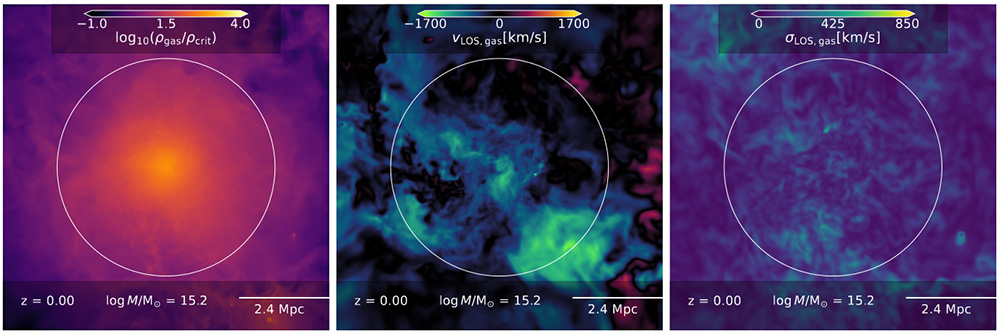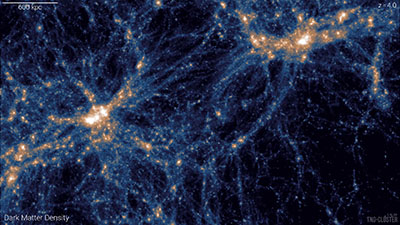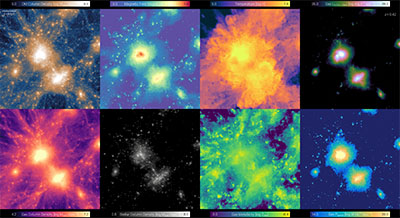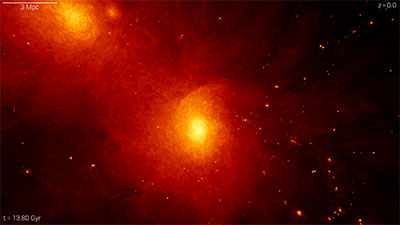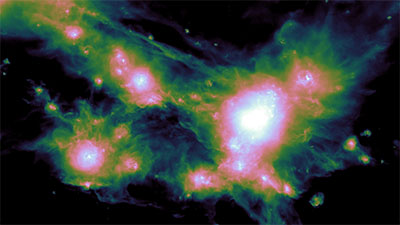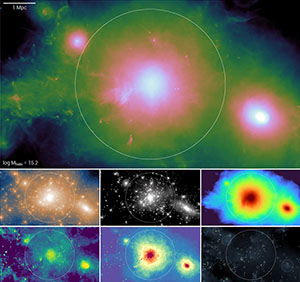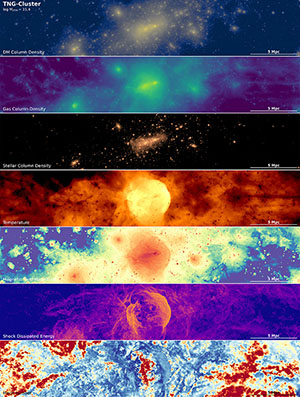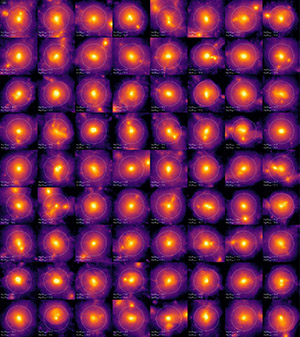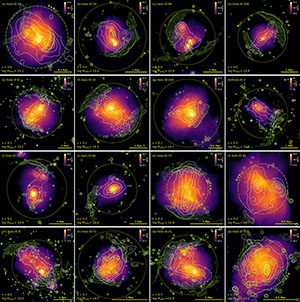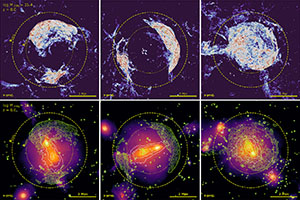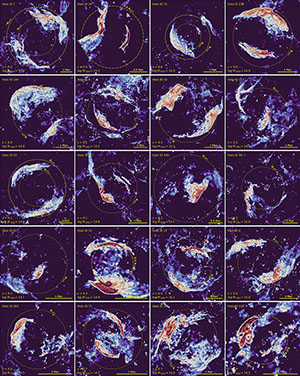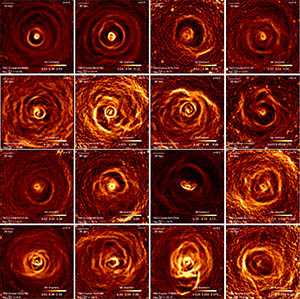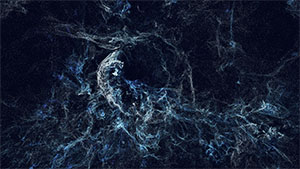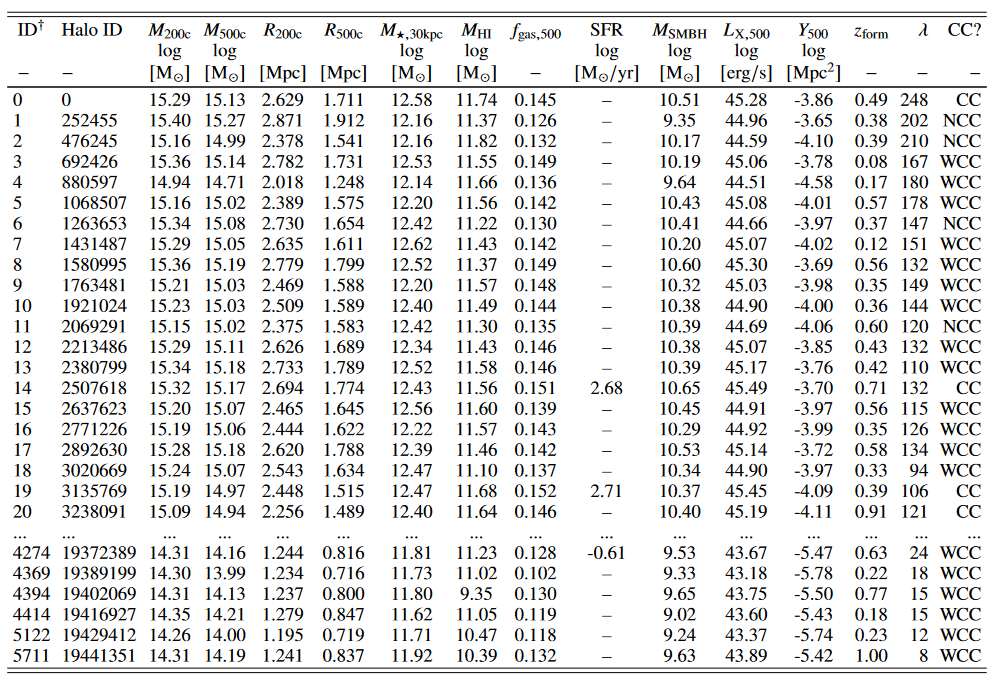Scientific Motivation
Galaxy clusters are the ultimate outcome of the hierarchical assembly of structure. Their stellar bodies, supermassive black holes (SMBHs), dark matter halos, and gaseous atmospheres are all constructed from the collective merging of thousands, if not tens of thousands, of smaller constituents. Clusters are the most massive gravitationally bound structures in the Universe. They host the most massive galaxies, the most massive SMBHs, and the largest populations of satellite galaxies that exist. The dynamics and physical processes at play in the hot plasma of the intracluster medium (ICM) are complex, diverse, and observable. They are cosmologically rare, yet form a crucial observational probe of our cosmological model.
TNG-Cluster has three principal scientific goals:
- (i) to understand the gas physics of the intracluster medium,
- (ii) to provide the necessary observables for precision cosmology in the next decade,
- (iii) to explore the assembly of the most massive galaxies and their surrounding satellite galaxy populations.
By well-sampling these rare structures we have simulated a sizeable sample of massive clusters and galaxies. The excellent numerical resolution, combined with the rich features and physics of the TNG model, enables novel science.
In particular, we can study the interplay of galaxy interactions, SMBH feedback, turbulence, magnetic field amplification, non-thermal support, and shock formation and propagation in shaping the properties of the ICM of clusters. This is the gas that, having been heated to temperatures of 10 million Kelvin or more, fills massive dark matter halos and, in turn, affects the evolution of galaxies therein. For example, how do kinematic turbulence and SMBH-driven outflows influence the observable velocity structure of the ICM? How are the location, strength, and morphology of shock fronts regulated? What dominates the gas structure in the cluster core vs. its outskirts? How do the thermodynamical properties and kinematics of the ICM depend on the feedback from SMBHs? Do mergers between clusters change the picture?
TNG-Cluster enables us to develop mock observations of the ICM to compare against, and gain insights from, current and upcoming observations. These range from radio wavelengths from synchrotron emission, for connections to observations with e.g. LOFAR, MeerKAT, and in the future SKA, to the mm and X-ray bands. For the latter, two fundamental observables characterize galaxy clusters: the Sunyaev-Zelvodich effect (SZE), whereby photons from the cosmic microwave background interact with free electrons in the ICM plasma, and X-ray emission, primarily from thermal bremsstrahlung. Forward modeling will enable quantitative connections with existing and future X-ray observatories (Chandra, XMM-Newton, eROSITA, XRISM, and future ATHENA and LEM) and for the SZE from upcoming surveys (e.g. Atacama Cosmology Telescope (ACT), South Pole Telescope (SPT), Simons Observatory, CMB-S4).
In fact, X-ray detected clusters will play a key role in many precision cosmology experiments over the next decade. However, traditional cosmological pipelines suffer from an inadequate parameterization and marginalization over the key parameters of mass-observable relations. With TNG-Cluster, we can provide theoretically-motivated priors on the redshift evolution, shape, and intrinsic scatter of the relations between cluster mass and X-ray luminosity and temperature.
Finally, although only a few percent of all galaxies at the present day reside in the most massive and rarest dark-matter halos, these clusters contain a unique mixture of galaxy types. TNG-Cluster will provide an unmatched dataset for the theoretical study of brightest cluster galaxies (BCGs), satellite galaxies, as well as of proto-clusters at high redshifts. We can ask, for example, how do physical mechanisms such as mergers, star formation, gas accretion and SMBH feedback determine the mass and morphological evolution of BCGs? At what past epochs have they been disky and star forming? What causes galaxies shaped like flattened disks to transform into elliptical spheroids? What is the relationship between the BCG and cool-core clusters? How does the proto-cluster environment affect the evolution of galaxies that will become cluster galaxies?
Project Overview
The original IllustrisTNG project consisted of three volumes: TNG50, TNG100, and TNG300. These simulated regions of space 50, 100, and 300 comoving Mpc on a side, respectively. TNG-Cluster is instead a project that resimulates ~ 350 clusters drawn from a much larger, 1 Gpc3 volume, thirty-six times larger than TNG300.
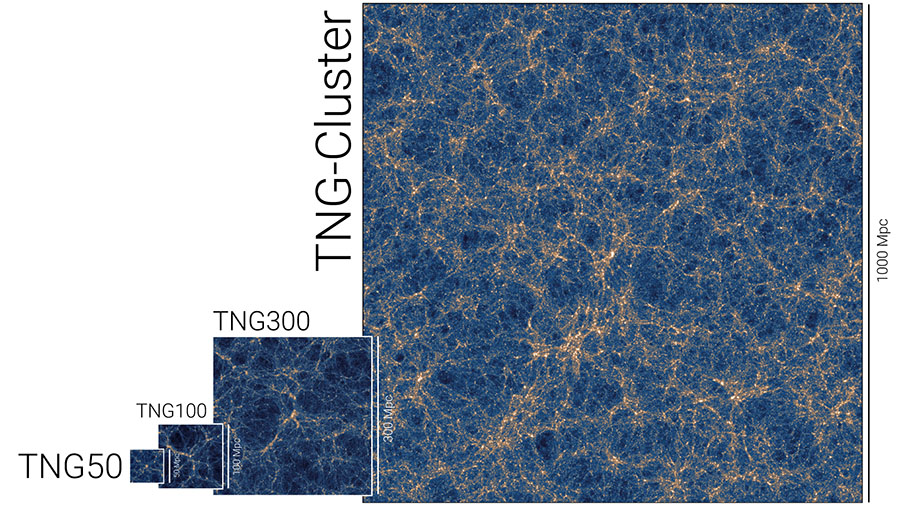
We keep -- entirely unchanged -- the IllustrisTNG galaxy formation model, as well as the numerical resolution. This new sample of hundreds of highly resolved, massive galaxy clusters enables studies on the assembly of high-mass ellipticals and their supermassive black holes (SMBHs), brightest cluster galaxies (BCGs), satellite galaxy evolution and environmental processes, jellyfish galaxies, intracluster medium (ICM) properties, cooling and AGN feedback, mergers and relaxedness, magnetic field amplification, and the galaxy-halo connection at the high-mass end, with observables from the optical to radio synchrotron and the Sunyaev-Zeldovich (SZ) effect, to X-ray emission, as well as their cosmological applications.
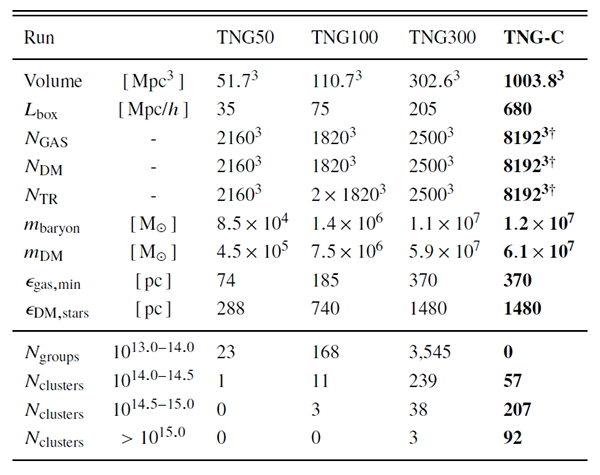
The table above shows details of the TNG-Cluster (right-most column) simulation in comparison to its smaller volume siblings. The values are: volume, box side-length, number of initial gas cells, dark matter particles, and tracers; the mean baryonic cell mass and dark matter particle mass; the gravitational softening length minimum for the gas, and the softening for the collisionless components at $z=0$; the number of groups (13.0 to 14.0), lower mass clusters (14.0-14.5), intermediate-mass (14.5-15.0), and high mass ($>$15.0) clusters. $\dagger$ = effective full-volume equivalent. We increase the statistics for halos $\gtrsim 10^{14.5} M_\odot$ by an order of magnitude, from ~ 30 objects to ~ 350. Likewise, we increase the sampling of the most massive and rare $\gtrsim 10^{15} M_\odot$ halos by a factor of thirty, from just three halos in TNG300 to ninety in TNG-Cluster. The combined $M_{\rm halo} > 10^{14} M_\odot$ cluster sample increases from 280 to 636 halos.
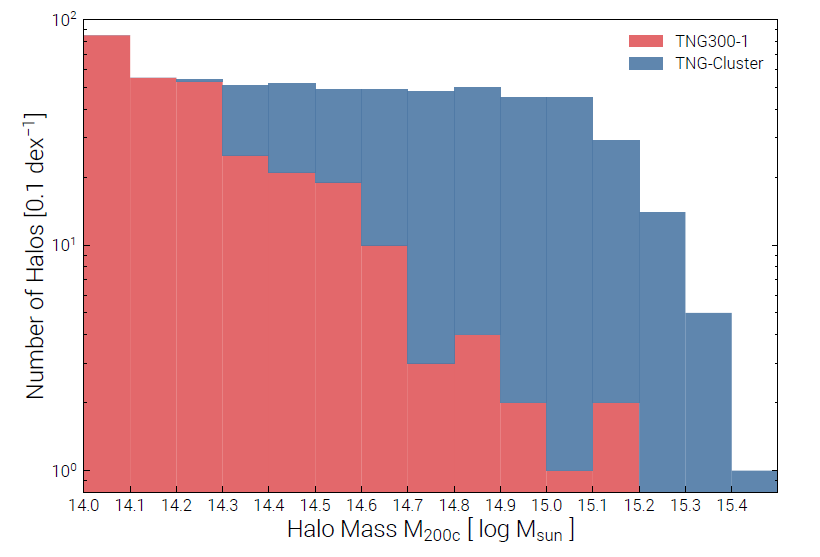
In total we simulate 352 clusters. The resulting mass function, stacking on top of the statistics already available from TNG300, is shown above. The TNG-Cluster halos are chosen randomly in 0.1 dex mass bins such that we (i) include all halos above $10^{15} M_\odot$, and (ii) compensate the drop-off of statistics in TNG300 from $10^{14.3}$ to $10^{15.0}$ to produce a flat distribution in halo mass over this range. The resulting sample of simulated clusters overlaps with current observational large-survey programs targeting clusters in the local as well as high redshift Universe, such as PSZ1-cosmo, ACT-DR5, the ROSAT MCXC catalog, SPT-ESC, the XXL 365 catalog, and the eROSITA all-sky catalogs. We also simulate numerous analogs of well known local clusters such as Coma, Perseus and Virgo, as well as rare examples such as the Bullet Cluster and El Gordo.
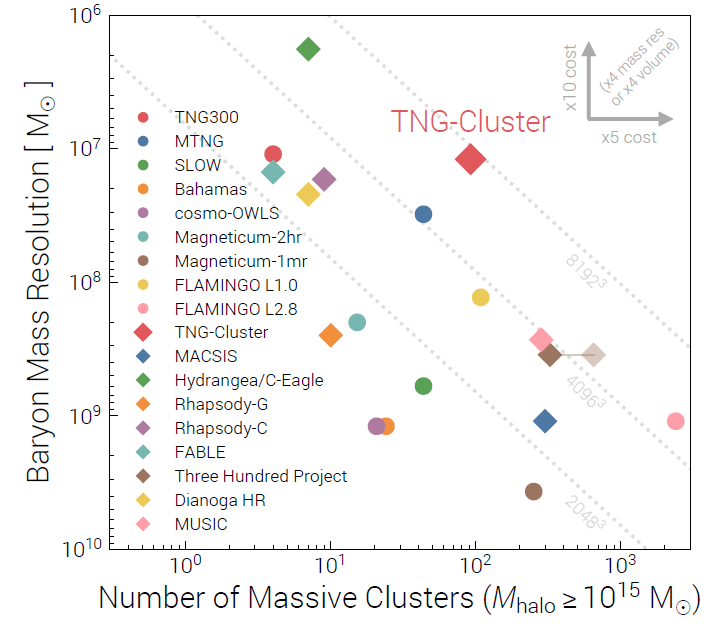
The TNG-Cluster simulation occupies a unique combination of large volume and high resolution. The figure above places it into context. We show TNG-Cluster (large red diamond) in comparison to other cosmological volumes (circles) and zoom simulation projects (diamonds) at z ~ 0. The x-axis shows the number of simulated massive clusters, with halo masses above $10^{15} M_\odot$. The y-axis shows the resolution, given in terms of the mass of the baryonic mass element. The challenge in simulating massive clusters with high resolution is in moving towards the upper right corner of this diagram.




